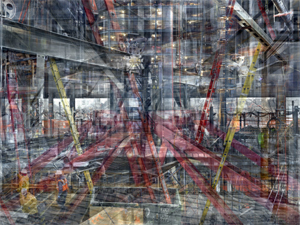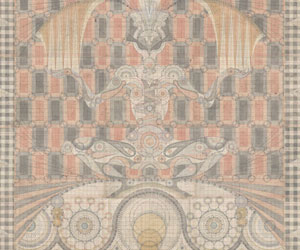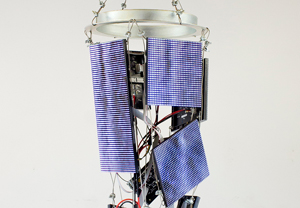Promises, Promises
John Haberin New York City
The 2021 New York Art Fairs
I was finally going to do it. This was the year I would skip the art fairs.
Not last year, at the height of the pandemic, when the fairs shut themselves. No, this year, just when New York is roaring back—or desperate to think so. They were coming right after Labor Day, when the arts always stage a comeback from the heat and quiet of summer. At least five fairs have moved from spring, apart from a stripped-down version of Frieze in The Shed. The most prominent of all, the Armory show, was the first to decide, and others followed. Could I bring myself to skip them after all? 
I told myself that I could, but then nothing is ever settled in art. How would the Armory Show do in its new location, I wondered, the Javits Center? It is certainly closer to mass transit and Chelsea galleries than its location in past years, the midtown piers. A subway extension to the Hudson Yards promised a revival of the convention center as well. Still, dozens of galleries are holding off, taking a slot instead in "Armory Live," the Armory Show online. Maybe "virtual fairs" really are the way to go.
How would the Independent, now in its third location, do in its new spot near the South Street seaport? I had already headed that way this summer to catch the ferry to the NADA art fair. It is still as scrappy as the houses on Governors Island and a lot less run down. I would miss the Independent for its quality as well—and Art on Paper given my love of prints, drawings, and the artist's book. And how about a whole new alternative in the Future fair, just a block from where the Moving Image fair had its run? It promises diversity, with galleries led by women and people of color, but how well would they represent emerging art and an emerging New York?
And wait: is that already a review? A compulsive critic can hardly resist. So there I was, at the last minute, hoping for press admission or attending without it. Galleries would just have to wait. But would it pay off?
No fair!
I had promised to spare myself the fairs for a long time now. They take time and money for what a New Yorker can see any day, in the galleries. Exhibitors, too, pay a steep price, when many are already struggling. Something, I kept thinking, has to give. When Frieze and other art fairs shut for Covid-19, an astute dealer called it the death of fairs once and for all. When they went online instead, it seemed in accord with a trend in galleries as well, toward "virtual exhibitions."
The fairs make life hard on a reviewer, too. To be sure, some booths are bound to stand out. They can do so with a creative juxtaposition or a single artist. But a good critic should, I keep insisting, do more than pick winners. And how much can a fair add to what you might already know about an artist? Even if a dealer had the means to command attention, you would be rushing past to see many more.
I could try to sum up the fairs and what makes each of them unique. What makes them, as a panel discussion had it, an "irresistible force?" I could take you past the obvious players to alternative fairs that you might otherwise have missed. And I have, for years, because this Web site is all about seeing more. (You can check out past reviews to your heart's content.) Yet that, too, can grow stale.
How often can I describe the Armory Show as an encyclopedia of high-end dealers? How much comfort can I find in "Presents," an area at back reserved for younger galleries? (Defined generously as under fifteen years old, they pay less to attend.) How often can I point to the Independent as a focused alternative? It gives you time to make your own discoveries. It is also precisely what midlevel galleries at their best can bring—and why threats to their brick-and-mortar existence are such a threat to art.
Can I keep up with Spring Break in its fourth location, going back to dark halls above a central post office? (They have since taken on the brightness of the Moynihan Train Hall.) Can I note yet again its curated chaos? How many years can I stick with the self-curated trash of less prominent alternatives like Superfine! (set for late September, with an exclamation point) and now Clio? Can I repeat my disappointment with the gaudy trash in Volta (which has skipped this year) or with Art on Paper, for packing in the posters and prints?
The move to fall discouraged me all the more. No other week makes it so hard to keep up—with well over a hundred gallery openings. Why could the fairs not have chosen November, as has the Art Dealers Association of America? It will benefit from less competition, tourist season approaching, and museum exhibitions already underway. But then the ADAA Art Show is always a class act. And yet I went for the fairs, misgivings intact.
Signs of hope
The Independent would be happy to serve all your shopping needs, but not by having it all. Count on it instead for galleries that reliably set the pace. I had not thought of the Battery Maritime Building as more than a ferry stop.  I had not known its view of the harbor or its no longer functional but still spectacular architecture. Thanks to its regular tenant, Cipriani, it now comes with an upscale restaurant's plush carpets, terrace café, and paintings by Julian Schnabel. Now on one floor, the fair gets to sprawl out without losing its intimacy.
I had not known its view of the harbor or its no longer functional but still spectacular architecture. Thanks to its regular tenant, Cipriani, it now comes with an upscale restaurant's plush carpets, terrace café, and paintings by Julian Schnabel. Now on one floor, the fair gets to sprawl out without losing its intimacy.
It seems more willing to embrace passion and politics as well. While Peter Halley puts in an appearance (with Montauk's The Ranch), something fresher is going on. Just a step past Chase Hall, whose portraits defy expectations for race and class (at Chicago's Monique Meloche), Jameson Green (at Derek Eller) packs black faces into canvases that might depict street violence or hard work, with echoes of Raft of the Medusa by Théodore Géricault. Elsewhere Che Lovelace (at LA's Various Small Fires) depicts faces from his native Trinidad. A step from Karla Knight, at a gallery devoted to outsider art (Andrew Edlin), Louise Despont (at Nicelle Beauchene) brings her fine line and restless energy to mandalas on antique ledger books. Is the proximity an accident—or a measure of art today?
Spring Break has come a long way from its dingy, dark, and desperate beginnings. Now in an office building on Madison Avenue, it has not galleries, but well over a hundred curators—and not booths, but cubicles and common areas, like a corporation turned arty and run mad. (And here you thought you would never return to a midtown office.) Beth Livensperger converts one wall to a workspace all her own, with a meeting that copies of a single young woman are unable to convene or to leave. Mostly, though, the fair's artists are all but impossible to tell apart. Think of them rather as a single installation, spanning two floors, with exaggerated painting, larger than life sculpted humanoids and animals, and a world of soil, office towers, gym equipment, and beach toys to accommodate them all.
The fairs have weathered a tough year, but Art on Paper holds out signs of hope. Exhibitors fill all four aisles on an East River pier, just as before. Better still, it holds out hope for a fair's content. It does cede one of four "artists projects," in common areas, to a vendor of posters. Yet for once it has its share of art—from cut paper to oil on canvas. Stalwarts of book art like Central Booking round out a promising picture.
Another project consists of photos by Shai Kremer (with Art Bond NY), overprinted to show the World Trade Center construction site as haunted by fragmentation and destruction. They evoke an image of New York closer to that of tourists (aka collectors) than New Yorkers, but still worth remembering. The remaining two projects are true installations. Rebecca Hutchison (with Duane Reed) and Samuelle Green create their sculpture from discards, and both mean to evoke natural growth. If the first looks more like ice cream cones and the second like enormous teddy bears blown in by Hurricane Ida, enjoy. Up close they reveal their many layers of rolled paper and type.
Zürcher gallery still calls its Salon Zürcher a subsidiary fair to the Armory Show. In practice, it amounts to a solid group show, of "women of spirit." Janet Passehl shows the allusiveness of common materials, in what might be the remains of a canvas or damaged clothes hung out to dry. Abstraction ranges from crossing geometries by Brigitte Engler to sculptural frames by Rebecca Smith and brushwork intermixed wet on wet by Fran O'Neill. Scribbles by Rosaire Appel may yet settle into a relic or a musical score. Painterly photos by Laurel Marx evoke blurred interiors, confining but rich in memories and in light.
A focus on the present
I confess to having little patience with the ragtag artists in Clio, but a small alternative fair promises a brighter future. So why does the Future Fair look so dreadfully like the present? It occupies Chelsea's Starrett-Lehigh building, with its memorable rounded corners. Inside, too, it cuts corners. Even a staunch defender of new media features abstract moving images and outright paintings, by Sara Ludy (with Bitforms), presumably because they are collectible. Among the large work, Ojo Ayotunda's black men finding a restful moment (with Martha's Vineyard's Nyama) could stand for the fair's lethargy—and T. L. Sulien's mural of a dancing robot (with LA's Seasons) its eagerness to please.
Go instead to the Armory Show online and click on exhibitors, and that is exactly what you get—a view of their galleries. These are spaces that an art fair just cannot offer. The show has claims of its own anyway, the claims of serious money. It welcomes anyone, as long as they have business to do. Think solo shows would get more attention, especially now that anyone with a browser can run through lists of gallery artists? Fine, we have a section for that, too. 
The fair has abandoned its section for modern art. Has it lost the ability to broach the past, or has it gained in its willingness to confront the present? Maybe both. It has added a "Focus" section for art about "today's most pressing issues," although even there overtly political art is rare. You might find instead jagged text painting by Marie Watt (at Marc Straus) or baby-blue bows in women's hands, by Sarah Slappey (at Sargent's Daughters). Three off-site installations are still easier to overlook.
"Presents," for younger galleries, remains the show's most consistent present to New York. Rachel Rosheger and Jeanne Liotta (at Microscope) bring a rare touch of new media, with images of storms and other worlds, while Hayley Barker (at Shrine) reflects his gallery's dedication to outsider art, even in a view in paint of a Brooklyn backyard. Yet too much of the section, including images of African Americans, struggle to look timely. That leaves the fair's "Solo" section. It can hope to recover the past, including a claim for Nancy Holt (at London's Parafin) as groundbreaking earthworks and conceptual art. Far more often, though, the section lays just another claim to the present.
A 3D storefront by Patrick Martinez (at LA's Charlie James) stops short of making a statement, even in neon. Who cares about cities anyway when you are off on the piers, past the Hudson Yards? Kenny Rivero (at Charles Moffett) is whimsical but elusive, in a softly stained look going back to Joan Miró. Torrential flows of paint by David Gilbert (at Klaus von Nichtssagend) are softer still. Andrea Joyce Heimer (at Half) paints a house at dawn, with someone in the attic doing something suspect. Migrating swans pass in patterning close to abstraction—and her title adds, Dogs Bark Too.
For all that, the most remarkable thing about the Armory Show is its brevity. This once, it is manageable, with motivation to look. Now if only future years could promise the same. Meanwhile I shall just have to wait for the Art Show in November and Frieze when it comes. Unless, of course, I can finally pass on the art fairs. Or is it already too late?

These New York art fairs ran mostly September 9–12, 2021. Related reviews report on past years, the spring 2022 art fairs, fall 2022 art fairs, spring 2023 art fairs, and fall 2023 art fairs to come, claims for the death of art fairs after Covid-19, and a panel discussion of "Art Fairs: An Irresistible Force?"




